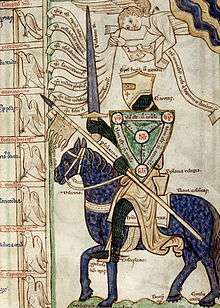Waffenrock
Waffenrock ([also Waffenkleid] English: surcoat or tunic) was originally a medieval German term for an outer garment,[1] worn by knights over their armour.[2]
Later, Waffenrock became the generic term for any military uniform, including dress and parade uniforms, and also referred to epaulettes or shoulder boards with rank insignia, as well as uniform cuffs, badges and other insignia. As of 1945, the term is no longer in use by German speaking armed forces, though the Swedish term for a military tunic is the cognate vapenrock.
Historical roots
Waffenrock was derived from the substantive wâfenroc or wâpenroc ("weapon tunic") of knights. It was often made from expensive silk cloth. The colours of this cloth corresponded to those on the shield quartering. In spirit of this, the heraldic figures on the coat of arms were frequently designed by gold and silver embroidery.
In the Prussian Army, the service coat was common called Montierung. It was renamed to Soldatenrock ("soldier's tunic") in October 23, 1842, by the Prussian cabinet order of His Majesty (de: allerhöchste Kabinettsorder). In 1843, it was finally renamed to Waffenrock.[3] All German-speaking armies commonly used this wording, except for the Austro-Hungarian Army (later Austrian Army), where the designation Adjustierung was in use.
Historical examples
The gallery below shows examples of Waffenrock over the suit of armor

Alexander Nevsky in Waffenrock with suit of armor and sword 
Saint George in suit of armor, with tunic (de: Waffenrock) and lance 
Knight in suit of armor and Waffenrock, preparing to battle _von_Anhalt.jpg)
Fighting knights in suit of armor and Waffenrock Tourney in suit of armor and Waffenrock (16th or 17th century)
The gallery below shows Waffenrock examples until 1945

Frederick II of Prussia in Waffenrock (dress tunic) 
Waffenrock k.u.k. 94th InfRgt, Stabsfeldwebel in white egalisation colour 
Waffenrock k.u.k. colonel of the engineer corps in steel-green egalisation colour 
Waffenrock of a customs inspector in Hamburg 1888-1919 
Waffenrock Hauptmann of the Wehrmacht ca. 1939
See also
References
- ↑ Langenscheidt´s Encyclopaedic Dictionary of the English and German language: „Der Große Muret-Sander“, Part II German-English, Second Volume L–Z, 8th edition 1999, ISBN 3-468-01126-1; p. 1.752 – Waffenrock / Service coat tunic.
- ↑ BROCKHAUS, The encyclopedia in 24 volumes (1796–2001), Volume 23: 3-7653-3683-1, page 488, definition: Waffenrock.
- ↑ Word and tradition in the German Army (de: Heer), by Transfeldt – v. Brand – Quenstedt, 6th increased edition, Hamburg 11 H.G. Schulz 1967, p. 2, roots of the noun: Waffenrock.